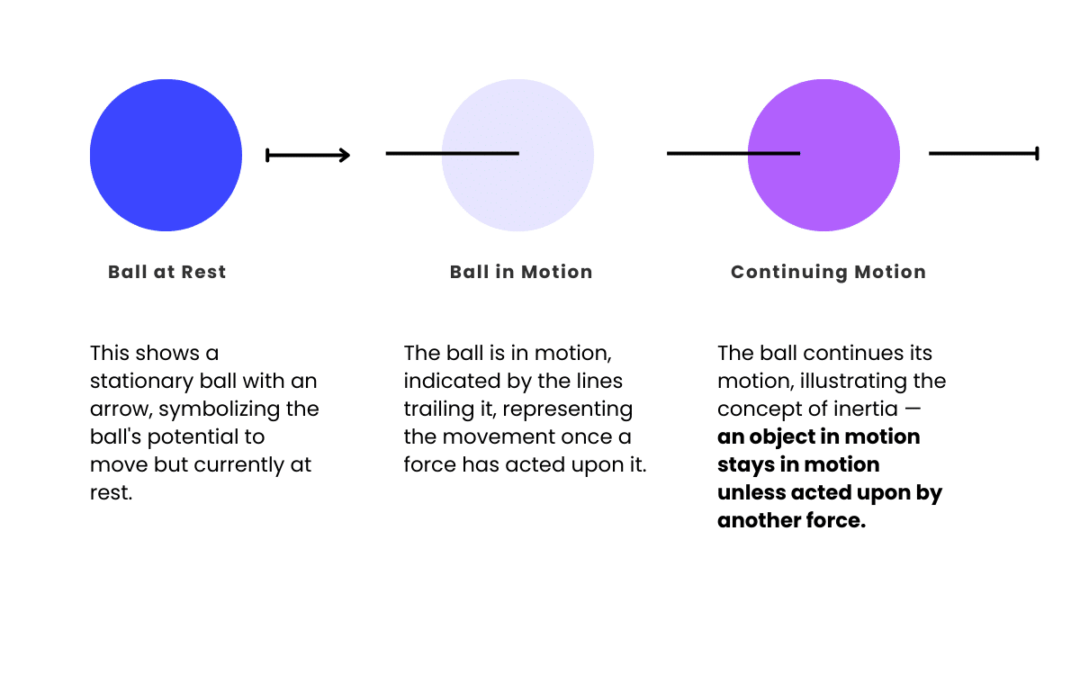Reading Time: 4 minutes
Key Points
1. Inertia in Physical Motion:
-
- In the physical world, inertia explains why moving objects tend to keep moving and stationary ones remain at rest unless forces like friction or external interventions alter their state.
- This principle is fundamental in understanding and predicting the motion of objects in our universe.
2. Inertia in Decision-Making and Behavior:
-
- Once a path or routine is established, continuing along the same route requires less energy than initiating a change.
- This can lead to sticking with familiar patterns, even when they’re no longer optimal or beneficial.
3. Inertia in Organizations and Systems:
-
- Established procedures, cultural norms, and entrenched processes resist change, favoring the status quo.
- While this can ensure stability and consistency, it can also hinder adaptation and innovation, especially in rapidly changing environments.
Understanding Inertia
Inertia, a concept rooted in physics, has broad applications, from understanding physical motion to analyzing human behavior and organizational dynamics. At its core, inertia is the tendency of an object in motion to stay in motion and an object at rest to stay at rest, unless acted upon by an external force. This principle extends beyond the physical realm, offering insights into how we make decisions and how systems operate.
Where Inertia can be found
Embracing Inertia: Navigating the Path to Action
Have you ever found yourself longing to start a new habit, like journaling more often or delving into that book sitting on your shelf? It’s a common experience where the initial step seems the hardest. Once you begin, whether it’s pen to paper or eyes on the page, the flow comes more naturally. You’re not alone in this struggle; it’s a shared human experience, a phenomenon rooted in the principle of inertia.
Lightening the Load: You’re Not Alone
Knowing that this is a shared struggle can be comforting. It’s not just you finding it hard to overcome the inertia of starting; it’s a universal human experience. When you find yourself being hard on your lack of action, remember that the initial push to change from ‘rest’ to ‘motion’ is universally challenging.
Inertia is Newton’s first law of motion, a fundamental principle of physics. Newton summarized it this way: “The vis insita, or innate force of matter, is a power of resisting by which every body, as much as in it lies, endeavors to preserve its present state, whether it be of rest or of moving uniformly forward in a straight line.”
When developing his first law, Newton drew upon the work of Galileo Galilei. In a 1624 letter to Francesco Ingoli, Galileo outlined the principle of inertia:
I tell you that if natural bodies have it from Nature to be moved by any movement, this can only be a circular motion, nor is it possible that Nature has given to any of its integral bodies a propensity to be moved by straight motion. I have many confirmations of this proposition, but for the present one alone suffices, which is this.
I suppose the parts of the universe to be in the best arrangement so that none is out of its place, which is to say that Nature and God have perfectly arranged their structure… Therefore, if the parts of the world are well ordered, the straight motion is superfluous and not natural, and they can only have it when some body is forcibly removed from its natural place, to which it would then return to a straight line.
Inertia is the force that holds the universe together. Literally. Without it, things would fall apart. It’s also what keeps us locked in destructive habits, and resistant to change.
Cognitive Inertia
Tendency to Stick to Old Beliefs:
- We often cling to familiar ideas and habits, even when they’re outdated or unhelpful. Changing these beliefs requires effort and overcoming confirmation bias, where we only seek information that supports our existing views.
Difficulty in Adapting to Change:
- Failing to adapt to environmental changes can be harmful. Our perspective, often limited by our direct involvement, can blind us to necessary changes that are apparent to others.
Inertia in Everyday Decisions:
- Cognitive inertia makes changing habits challenging. For instance, despite knowing better options, many people stick with their original bank due to the effort required to switch.
Balancing Inertia’s Impacts:
- While inertia can sometimes be beneficial in maintaining stability, often it’s crucial to overcome it to initiate or change something.
Overcoming Inertia:
- The initial effort to overcome inertia is the hardest. Once movement starts, progress tends to become smoother.
- Ernest Hemingway’s writing technique exemplifies this. He stopped working when he still had momentum and started each session with one true sentence to overcome inertia.
Applicability:
- The key is to start with a small, manageable task to build momentum.
…death is the destination we all share. No one has ever escaped it. And that is as it should be, because death is very likely the single best invention of life. It’s life’s change agent; it clears out the old to make way for the new … Your time is limited, so don’t waste it living someone else’s life.
Steve Jobs
Self-Inquiries and Actionable Practices
1. Start Small: Just like Hemingway’s approach to writing, begin with a small, manageable task. It could be writing one sentence in your journal or reading a single page.
2. Build a Routine: Set a specific time for your activity. The regularity can help in reducing the mental barrier to start.
3. Create a Motivating Environment: Make your reading nook inviting or keep your journal in a place where you’ll see it often.
4. Celebrate Small Wins: Acknowledge the effort it takes to start. Each small step is a victory against inertia.
5. Seek External Motivation: Sometimes, a little nudge from a friend or an inspiring quote can be that external force to get you moving.
6. Identifying Inertia in Personal Habits:
Reflect on aspects of your life where inertia might be holding you back. Are there routines or habits that persist simply because they’re familiar, not because they’re the best choice? What small, manageable action can help you build momentum?
7. Overcoming Inertia for Personal Growth:
Can you make setting new challenges or consciously breaking out of comfort zones light and playful?
8. Adapting to Inertia in Organizational Settings:
In your workplace, are there areas where inertia is hindering progress? Where can you propose or support changes that encourage agility and responsiveness, while respecting the benefits of established systems?
Embrace the Journey:
Remember, the journey of a thousand miles begins with a single step. Whether it’s journaling, reading, or any other activity, the key is to start. Overcoming inertia might be challenging, but it’s a hurdle we all face. Once you’re in motion, you’ll find it much easier to keep going.

